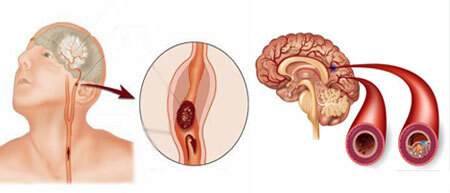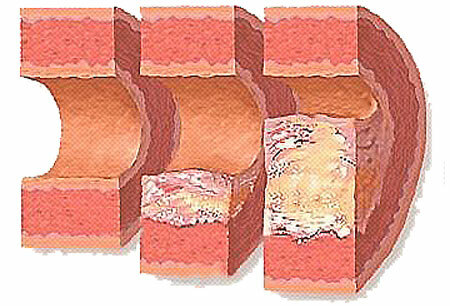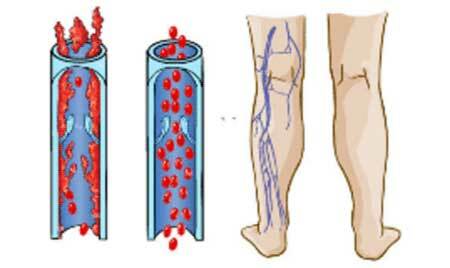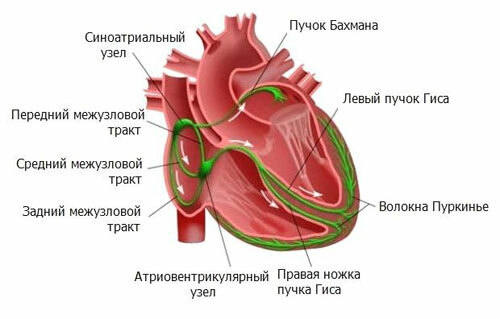This type of disease is also called "cerebral atherosclerosis."It is she who is responsible for the background on which ischemic stroke develops in mature and old age, there are "microinsults" or transient ischemic attacks.
But, apart from such serious diseases, atherosclerosis can, for a long time, change the personality of an elderly person and bring it to dementia.
What is it? Atherosclerosis of the cerebral vessels is a long-term disease of the cerebral vessels( only the arterial segment), as a result of which cholesterol and some other lipoproteins in the form of plaques are deposited on the inner wall of the cerebral vessels( on the intima).These intravascular plaques are called atheromas.

As a result, the lumen of the vessel gradually narrows and the tissues of the brain, which are blood-filled by this vessel, begin to experience chronic fasting, which leads to the appearance of symptoms of the disease.
Atherosclerosis is dangerous in any location: in the arteries of the lower extremities, it can cause sudden thrombosis and gangrene, in the coronary vessels of the heart it is the forerunner of the infarction.
Contents
- 1 Causes of cerebral atherosclerosis
- 2 Symptoms of cerebral artery atherosclerosis
- 3 Treatment of atherosclerosis of the vessels of the head moss
- 4 Complications of atherosclerosis
- 5 Prevention
Causes of cerebral atherosclerosis
Cerebral atherosclerosis has no special reasons, since this disease is systemic and causes commonfor any localizations. These include:
- The failure of the internal vascular layer - the endothelium. It can be hereditary or autoimmune lesion;
- Viral Theory. Endothelium of the arteries is affected by infections( herpetic infection, mononucleosis);
- Genetic theory. In the case of the development of hereditary family dyslipidemia and an increased incidence of heart attack and stroke.
There are also chlamydial, monoclonal, autoimmune, hormonal and many other theories of the onset of atherosclerosis. But much more important than just the reasons are the risk factors that can predispose to turn into a disease.
The risk factors with proven effect on the development of cerebral atherosclerosis include:
- Long-term smoking experience;
- Elevated cholesterol( cholesterol), which is calculated by sex and age;
- Hypertensive illness or symptomatic hypertension. The main factor is the blood pressure above 140 \ 90 mm Hg.st;
obesity and overweight; - Diabetes mellitus, especially insulin-dependent or type 1, hypothyroidism.
In addition to these risk factors, hypodynamia, chronic stress, and nutrition are important.
In women, the development of cerebral atherosclerosis leads to oppression of ovarian function in the postmenopausal period.
Symptoms of cerebral artery atherosclerosis

We can conditionally divide the course of the disease into several periods:
- The initial stage in which a person's working capacity and sociability are preserved, and the symptoms of the disease are identified as separate complaints;
- Progression of the disorder. This phase is characterized by the appearance of one or several leading syndromes, for example, ataxia, disseminated neurological symptoms, pseudobulbar syndrome;
- The stage of decompensation, which is characterized by the development of atherosclerotic dementia and the inability to service oneself in everyday life.
Symptoms and signs of atherosclerosis of the head moss are very diverse, one meets with dozens of different diseases and can also appear in healthy people with nervous overwork. Therefore, the symptoms must necessarily be checked by testing, aimed at finding depletion of mechanisms of memory and attention.
Thus, the symptoms of atherosclerosis of the head mussel include:
- Asthenic manifestations: increased fatigue, lethargy, decreased efficiency, especially in the performance of mental work;
- Insomniac disorders: drowsiness during the day, insomnia at night, or frequent awakening and inability to sleep in the evening, as well as difficulty in morning awakening in earlier stages;
- Vestibulopathic disorders: noise and ringing in the head and in the ears, frequent attacks of dizziness;
- Cephalgic syndrome: a variety of localization and intensity of headaches appear, which are provoked by mental stress, weather change, emotional experience. These pains never reach high intensity, as with meningitis or migraines, but can reduce the quality of life for a considerable time;
- Memory and attention are reduced. There is a decrease in memory for current events with the preservation of long-term memory, and attention is quickly depleted;
- Depressive state. The patient experiences dissatisfaction, then irritability. He becomes closed, hypocritical, restless, anxious.
The course of the disease alternates with exacerbations and remissions: after rest, most of the symptoms pass.
With further progression of atherosclerosis, various neurological symptoms appear, and complaints become permanent: a tremor of the head and fingers appears, the gait changes: it becomes shuffling, reminiscent of the gait of a patient with Parkinsonism.
There are chewing lips, speech indistinctness, difficulties when remembering the names of words and objects, names of relatives and friends. There is deafness, blindness, or decreased visual acuity, cataracts.
Then changes in the personality of the patients are joined: the circle of interests is narrowing, he ceases to be interested in current affairs, communicates with friends, read books, discuss any interesting facts, and can sit for days on the window.

Then comes the emotional impoverishment: the patient, for example, quite indifferently can treat the death of a close friend, but arrange a tantrum over tasteless soup.
As a rule, at this stage, sleep disturbances acquire a persistent character: a patient can go to his room for hours at night, and sleep all day.
Character changes: a person becomes secretive, petty, suspicious. From the family and friends hide completely unnecessary things.
Then the gait disturbance progresses, the coordination of movements and the fine motor skills of the hands are disrupted. The patient experiences difficulty in using cutlery.
Against this background, focal neurological symptoms may occur, in the form of transient speech disorders, numbness in the limbs, or the appearance of weakness of them. With the disappearance of symptoms during the day, it is said about transient ischemic attacks, that is, "reversible micro-strokes."
If neurologic symptoms are persistent and irreversible, then they talk about the development of ischemic stroke with cerebral atherosclerosis.
The third, decompensated stage of the is characterized by the disinhibition of many reflexes, which in the normal state are restrained by the inhibitory effect of the cerebral cortex. These include the proboscis reflex, the Rossolimo reflex and many others that are characteristic of the elderly.
Patients become untidy with urine and feces, gluttonous, sometimes aggressive, stop recognizing others. Gradually they need care, up to feeding from a spoon. The disintegration of personality gradually shifts to a somatic level.
Often the death of such patients occurs "for no apparent reason".In fact, chronic constipation, autointoxication of the intestine leads to its paresis, and being in bed for several days leads to the development of hypostatic pneumonia. All together cause the death of patients, if weaken control and let them go to bed.
Treatment of atherosclerosis of the vessels of the head mussel

In order not to become a victim of such a sad progression, it is necessary to take timely measures for the treatment of atherosclerosis of the head moss. They consist of three main "whales" of equal importance:
- Non-drug therapy;
- Drug administration;
- Operative treatment.
Let's consider these methods consistently.
Non-drug therapies of
are very important at the initial stage, with completely reversible symptoms and low cholesterol levels. They lead to a full awareness of the patient's tasks, must be performed until the end of life, often signify a complete change in the patient's lifestyle and require strict self-discipline.
Therefore, with all the positive effects, medical recommendations are often not carried out because self-control and self-discipline are the "hardest" to accomplish things.
Nevertheless, to defeat the disease you need:
- Quit completely from smoking;
- Drink alcohol only in the form of dry wine, very moderately, not more than 150 ml daily;
- Power change. Diet "against cholesterol" is rich in unsaturated vegetable oils, fiber, seafood, and is known as "Mediterranean".From bakery products it is recommended to rough grind, bread stale, with refusal of baking. You should eat a lot of quality vegetables and fruits and limit the intake of animal fat. From smoked products, sausages, canned goods, cheese of aged varieties should be completely abandoned;
- It is required to lead an active way of life, to move, to swim, to visit the sun;
- It is necessary to normalize the body weight, "remove the extra pounds" and bring them into line with growth;
- It is required to comply with the sleep regime, and sleep as much as the body asks.
These measures, carefully performed within 3 months, give a noticeable lowering of cholesterol level and improvement of well-being.
Drug treatment

preparation Cholestyramine
Treatment of cerebrovascular atherosclerosis with drugs belonging to different classes:
- Aspirin and other disaggregants: reduce the chance of clot formation on the plaque, reducing the risk of stroke;
- Hypocholesterolemic drugs( Cholestyramine, Clopidogrel, Ticlopidine, Zocor, Lipimar, Lescoll, Krestor).Relate to different, groups, appointed by a doctor under the control of biochemical indicators, are taken for a long time and reliably reduce the risk of vascular complications;
- Unsaturated fatty acids( Omakor, Lipostabil);
- Non-steroidal anti-inflammatory drugs( improve trophic endothelium and prevent the onset of plaque formation);
- Nootropic and vitamin preparations improve mental abilities;
- Drugs to improve microcirculation stimulate nutrition in the affected parts of the brain. These include Pentoxifylline, Trental, Cavinton.
Surgical treatment
It is shown in severe stenosis of large brachiocephalic arteries, most often with occlusion of the internal carotid artery by thrombus by 80% or more, with the risk of separation. Endarterectomy is performed with restoration of blood flow and possible prosthetics.
Cerebral atherosclerosis of cerebral vessels, the treatment of which we described, can be successfully stopped at any stage of its development before it manifests itself as complications.
Complications of atherosclerosis
As mentioned above, the choice of catastrophes is small - ischemic or hemorrhagic stroke. The risk of ischemia is much higher than the rupture of a plaque-affected vessel. Therefore, ischemic stroke is a direct consequence of atherosclerosis and the prevention of ischemic stroke directly coincides with the treatment of atherosclerosis of the cerebral vessels, by all points.
Given that the stroke ends with signs of disability in 85% of cases, you need to take as responsible a treatment for cerebral atherosclerosis.
Prevention
Prevention of disease completely coincides with non-medicinal ways of treating cerebral atherosclerosis. If you start using them in their youth, before the "first bells" - you can say with certainty: stroke and senile dementia will not threaten you.
In conclusion, it should be said that the atherosclerosis of cerebral vessels, the symptoms and treatment of which we have considered, is the cause of death of people aged in developed countries and is a "disease of civilization".It must be remembered that up to the age of 45 he can not manifest himself at all.
It is up to this age and you need to start a fight with him so that he does not take you by surprise at adulthood.



